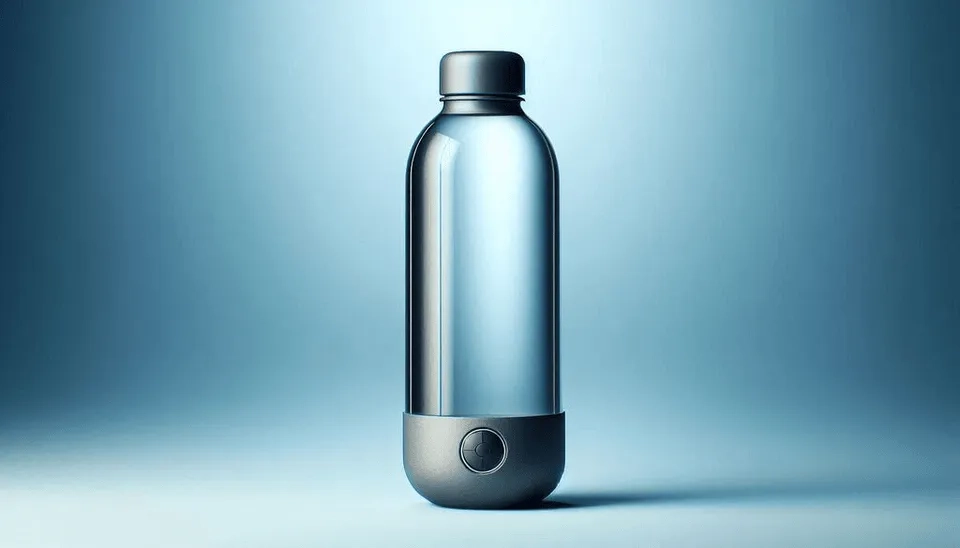
If you want a hydrogen water generator, but you don't know what features are vital to select the best one, reading this buying guideline will guide you through it. In every hydrogen bottle is a generator, which splits the water into two parts hydrogen and one part oxygen. Hydrogen and oxygen are generated using electricity through these plates. The positive plate generates the oxygen, and the negative plate, the hydrogen. This can increase energy, reduce inflammation, and reduce recovery times after workouts. Also, hydrogen water showed promise in reducing fatigue and increasing endurance.
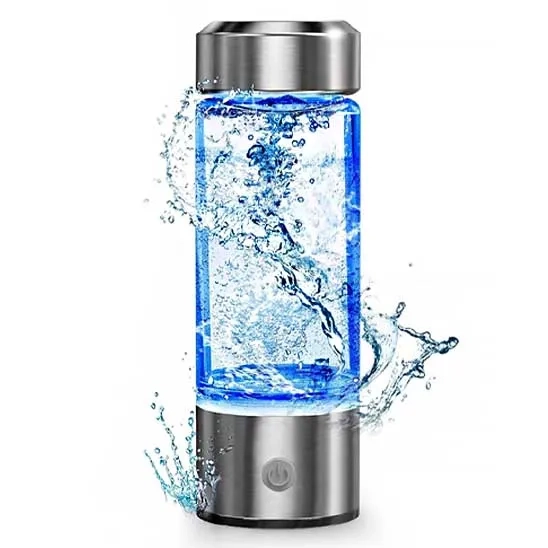
1. Key Considerations When Choosing a Hydrogen Water Generator
When selecting a hydrogen water generator, there are several paramount factors that need to be considered, including hydrogen concentration, electrolysis technology, material of the bottles, capacity and portability. Taking into account those criteria helps you select the best product. This section of the buying guide is devoted to those parameters. Here are some key factors to help you choose the right hydrogen water generator:
1.1. Purpose and Application
The primary goal of hydrogen water generator waters is to enhance water with molecular hydrogen. This can have many benefits for the human body, like reducing oxidative stress and neutralizing radical-free particles that are detrimental to the body. Also, harmful free radicals can be absorbed by the body when exposed to UV (Ultraviolet) radiation, air pollution, and other toxins. These bottles can be incorporated into the daily lives of individuals to increase the hydrogen content of the water, enhancing skin health and the energy of the body. Thus, the application of the hydrogen water generators is not limited to athletes, but also these products can be used by ordinary people as well. Another key consideration is shoes and hydrogen water generators, based on your specific needs. For example, athletes who can use these bottles frequently need a product that can produce large amounts of hydrogen in a short time for muscle recovery and prevent fatigue. While for individuals who utilize the product daily for enhancing general health, a bottle with low to medium hydrogen production can be suitable. Another factor is the design and portability of the hydrogen water generator, especially for users to use it on the go and in the gym, where a heavy and bulky bottle can induce problems and reduce portability. The bottles must be easy to clean to boost their lifetime and reduce maintenance. Overall, the application of the hydrogen water generators is based on your daily routine.
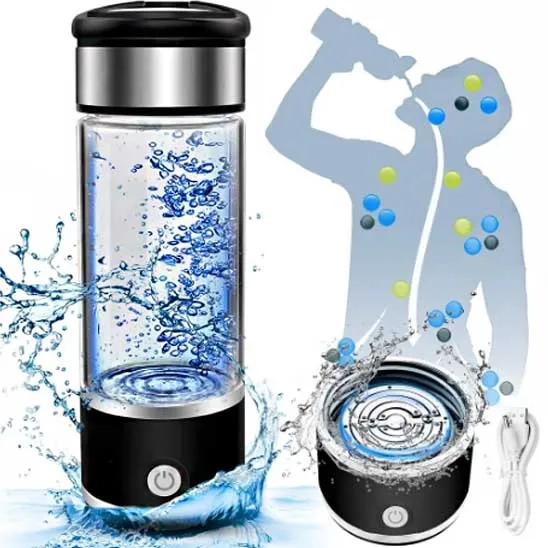
1.2. Types of Hydrogen Water Generators
Hydrogen water generators come in two main types: bottle-based and pitcher-based. Each type has distinct advantages and drawbacks, catering to different needs based on portability, capacity, and convenience.
1.2.1 Bottle-Based Hydrogen Generators
Bottle-based hydrogen water generators are compact and portable, making them ideal for individuals who need hydrogen-enriched water on the go. These generators use electrolysis to produce hydrogen quickly, often within a few minutes. Due to their small size, they are easy to carry and convenient for travel, work, or outdoor activities. However, their capacity is limited, meaning they may not be the best option for multiple users or those who consume large amounts of water.
1.2.2 Pitcher-Based Hydrogen Generators
Pitcher-type hydrogen water generators have a built-in electrolysis mechanism that gradually separates water molecules after filling the pitcher. They have a larger capacity, making them ideal for families or individuals who consume significant amounts of water. Their size allows multiple users to benefit from hydrogen-enriched water at once. However, they are bulkier than bottle-based models, making them less portable and unsuitable for travel. Additionally, the hydrogen generation process takes longer, often requiring 10 to 20 minutes before the water is ready for consumption.

1.3. Hydrogen Concentration
Hydrogen concentration is a crucial factor in hydrogen water generators. The hydrogen concentration is the amount of dissolved hydrogen molecules, which can be measured either in parts per million or micrograms per liter. A product is effective in producing a suitable level of hydrogen to maximize the health benefits associated with it. A concentration of 0.5 to 1.5 ppm is appropriate for molecules of dissolved hydrogen. However, more advanced models can provide a higher amount. It is important to note that the temperature and exposure to the air can reduce the concentration of hydrogen. Therefore, it is essential to take care of the hydrogen water generators to maintain their hydrogen amount. Users should monitor the hydrogen amount consistently to ensure the product maintains its performance.

1.4. Electrolysis Technology
Electrolysis is the fundamental mechanism in hydrogen water, which involves the separation of oxygen and hydrogen from water by using an electric current. Electrodes have the main duty for the separation process; while the electrolysis passes through the water, the oxygen molecules are absorbed in the anode and the hydrogen molecules are absorbed at the cathode. The quality of the electrolysis directly affects the performance of the hydrogen water generator; an appropriate electrolysis must be able to separate and dissolve the hydrogen molecules. Generally, there are 2 main technologies of electrolysis in the bottles, namely proton exchange membrane (PEM) and alkaline, which we discussed in this part of the buying guide.
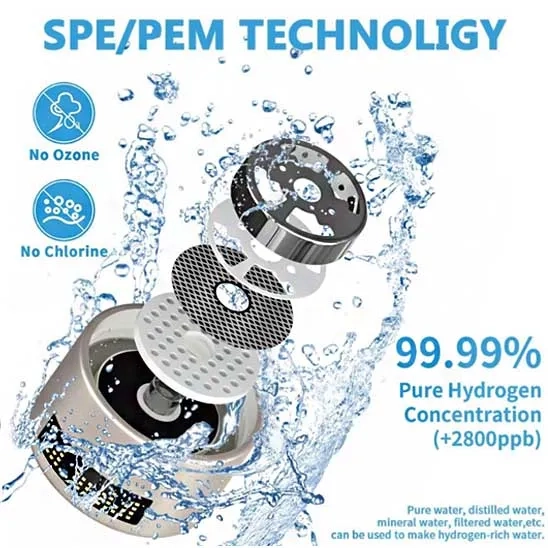
1.4.1 Proton Exchange Membrane Electrolysis
PEM electrolysis is an advanced process for the separation of hydrogen molecules by a solid polymer membrane, where hydrogen ions are allowed to pass while stopping the gases at the anode and cathode from mixing. This process produces high-quality hydrogen gas. PEM has a compact design, which allows it to be implemented in small spaces, like bottles, with high portability. Moreover, it can work with a variety of voltages and its response time is short. Solid polymer material is used in PEM electrolysis to conduct protons effectively. However, PEM has limitations as well. PEM has higher costs than other electrolysis methods due to the use of materials such as platinum. Also, based on the frequency of usage, the proton-conductive polymer membrane can degrade over time. Another drawback is that the PEM is sensitive to the quality of the water, especially ions like chloride. Water treatment plants use chloride, and tap water can contain high levels of this ion. Therefore, if the water you intend to use in the hydrogen water generator is of low quality, PEM electrolysis may not be suitable. If you use the product with low-quality water, it can degrade quickly and not perform optimally.
1.4.2 Alkaline Electrolysis
Alkaline electrolysis is another method of separation of water molecules that is subcategorized as solid polymer electrolysis, taking place in an alkaline environment in the presence of potassium hydroxide or sodium hydroxide. In this method, an electric current in an alkali metal hydroxide solution splits water molecules into hydrogen at the cathode and oxygen at the anode. In this method, the electrodes are made of nickel alloy to withstand an alkaline environment. Hydrogen water generators with alkaline electrolysis are cheaper than those with PEM. But they are slower and need more time to separate the molecules. Bottles with alkaline electrolysis are bigger than other types, which become bulkier. Moreover, they are less efficient and the water might contain trace amounts of oxygen.
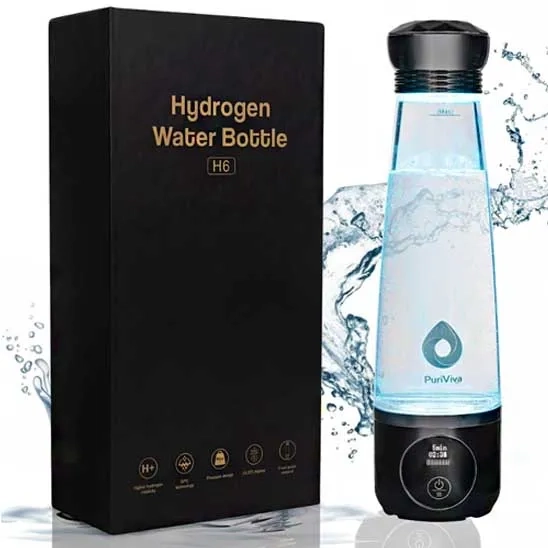
1.5. Battery and Charging Time
The battery of the hydrogen water generators must have enough capacity to ensure portability, as a lower capacity increases frequent charging and eliminates mobility. Their capacity can vary from 800 to 3000 milliamperes. Another factor is the number of cycles per charge; the bottles with 5–10 cycles are more suitable. A good hydrogen water generator must fully charge between 1.5 and 3 hours via a USB Type-C port. Most models come with lithium-ion batteries and overcharging protection. The efficiency of a hydrogen water generator depends not only on battery capacity but also on the quality of the electrolysis process. Higher-capacity batteries allow users to generate hydrogen-rich water multiple times before needing a recharge. Some advanced models feature LED indicators to display battery levels and charging status for user convenience. Durability is also essential, as frequent charging cycles can impact battery lifespan over time. Additionally, energy-efficient designs help optimize power consumption while maintaining high hydrogen concentration levels.
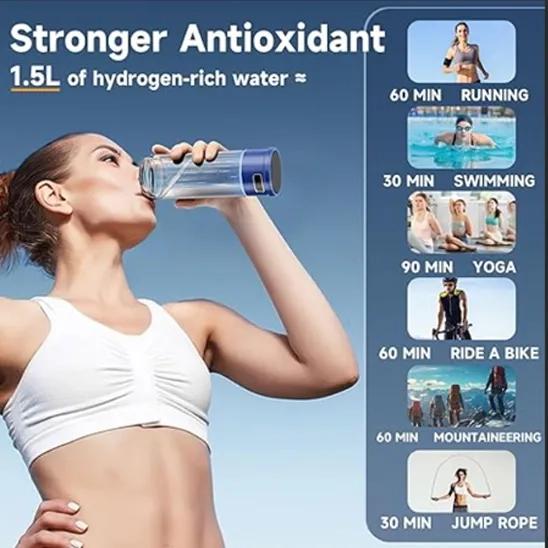
1.6. Capacity and Size
When considering buying hydrogen water generator bottles, capacity and size are important because they directly correlate with convenience and portability. The capacity of a hydrogen water generator can vary between 300 mL and 2 L. If you use the bottle frequently, choose bottles with higher capacity to minimize the number of refills. Lower capacity provides a portable solution for people who need less water during the day, while bottles with higher capacity are suitable for professional athletes. Another fact is that bottles with higher capacity need maintenance more frequently because more water is being separated into hydrogen and oxygen molecules, which minimizes their lifespan.
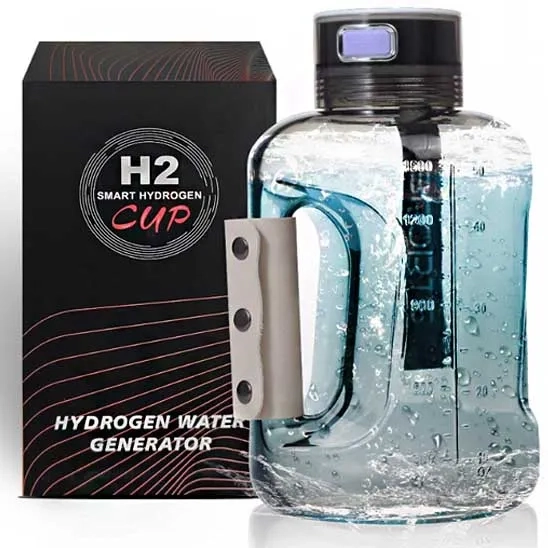
1.7. Material
The material of the water bottles for the generator is important and must be of good quality, free from harmful materials like BPAs. The material should be durable enough to minimize the need for frequent replacement as well as withstand minor impacts. The bottles for generating hydrogen water offer various materials; each has some benefits and drawbacks. Some of them come with borosilicate glass, which is durable and heat resistant, especially for users who plan to use the bottle under direct sunlight. Also, this glass is non-reactive, ensuring pure and high-quality water. It is fragile and heavier than other kinds, though. Moreover, another material is Tritan plastic, which is lightweight, BPA-free, and impact-resistant. But in cases of frequent usage, it can degrade and lose its quality. Another type is stainless steel ,which can keep the temperature of water for a longer period. In addition, it is more durable and can be resistant to damage. However, it is heavier than other types, reducing its portability. Additionally, it hinders the visibility of water. Users must consider several factors concerning the materials of the bottles for generating hydrogen water. For example, a bottle must be BPA-free, and it is better to have FDA approval or LFGB compliance. Moreover, glass can be dishwashed, but it's fragile; plastic has this ability but might scratch over time, decreasing its aesthetic appeal.

1.8. User Interface and Ease of Use
Hydrogen water generators must be user-friendly to avoid any confusion. Their function is to produce hydrogen-rich water. Many models have single or multiple buttons for turning the device on or off. The bottoms should be large enough to operate without any additional force. Some advanced models might offer touch buttons instead of mechanical ones, offering a more customizable setting to adjust temperature or hydrogen production time. Some other models to increase the functionality of the product offer auto shut-off features, which automatically power off the device after hydrogen generation to save power. Bottles must be cleaned after some time to prevent the accumulation of bacteria and maintain their performance. Parts of the hydrogen water generator bottles, like electrode plates or the bottom, can be separated for cleaning. Various premium models offer a self-cleaning model to pass the water through the electrolysis chamber.
1.9. Cost and Budget
When selecting a bottle for generating hydrogen water, cost is a crucial factor that helps narrow down your options. Several elements influence the price, including the electrolysis method, construction materials, battery capacity, and brand reputation. Understanding these factors can guide you toward the best choice based on your budget and needs. Entry-level models, typically priced below $100, feature basic designs with plastic construction and smaller battery capacities (800–1500 mAh), usually supporting 2–3 cycles per charge. While they effectively generate hydrogen-rich water, they often lack advanced features and durability. In contrast, models priced above $100 incorporate high-quality materials like BPA-free plastic or premium glass, larger battery capacities (often above 1500 mAh), and advanced electrolysis technology for higher hydrogen production. These premium models also offer additional features such as self-cleaning functions to prevent scale buildup, customizable hydrogen levels, faster infusion times, dual-chamber technology to separate harmful byproducts like chlorine and ozone, and enhanced filtration systems for purer water. While high-end bottles provide greater efficiency and convenience, it is important to consider hidden costs such as electrode plate replacements and specialized cleaning solutions, which may be required over time. Ultimately, the decision depends on individual needs—budget-friendly models are suitable for those seeking a simple and economical option, whereas premium models offer superior performance, durability, and advanced features for those looking for a more comprehensive solution.
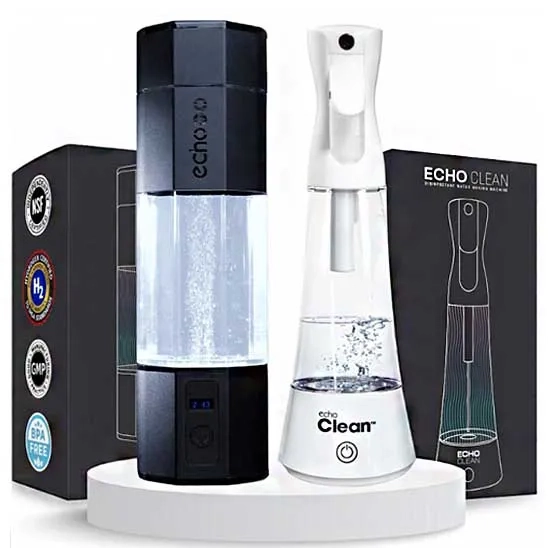
1.10. Customer Service
Customers can have the best experience using the hydrogen water generators with professional customer service. They can begin by aiding users before buying the products with educational content on how the hydrogen water generators work and, after buying, on how to replace the electrode plates and any troubleshooting. A suitable company must be responsible toward its clients in terms of filter replacement, providing electrodes in a short time, and renewing subscription services. Many models on the market come with warranties, which can be helpful because many bottles are used in gyms, where they could be subjected to impacts. Some companies offer free repairs or replacement options during the warranty period. Customer service can provide online material on its website, such as manuals, video guides, live chats, and troubleshooting articles to assist customers. A proactive company must support the customer after the duration of the warranty, providing easy access to replacement parts. When clients are facing issues, companies must have live chat, phone support, or email communication to solve the problems. Some companies offer online forums or social media groups for customers to share experiences. Such communication is extremely useful because customers share practical issues that devices might have.

1.11. Product Ranking
For selecting the best hydrogen water generator, all the criteria that we have mentioned must be taken into account. This process guarantees an informed decision. In addition, search online platforms such as Amazon and Alibaba and read the reviews and comments of the previous users who have experience using the products, aiding you in the product ranking. In addition, the article ‘Top 8 Hydrogen Water Generator Bottles in 2024‘ can be your preliminary choices, and then based on other criteria, you can add or delete the products on your list until reaching the best choice. In this article, Bayesian ranking was utilized for ranking the product. In the article, the LevelUpWay Glass Hydrogen Generator Water Bottle ranked first. It only takes 6 minutes to reach the optimal ORP (oxidation-reduction potential) level, and then you can send tiny hydrogen molecules to scavenge and neutralize the harmful free radicals that you absorbed when exposed to UV (ultraviolet) radiation, air pollution, and other toxins, with no side effects. The LevelUpWay portable hydrogen water generator offers a 1-year warranty on the product, along with a 30-day money-back guarantee and customer service.
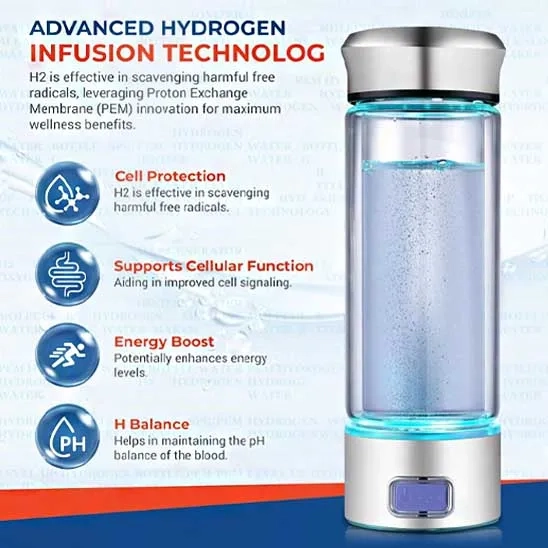
2. Comparing Different Types of Hydrogen Water Generators
This buying guide section helps you compare various hydrogen water generators, making it easier to find the ideal option.
2.1 Bottle-Based Hydrogen Generators
Bottle-based models, such as the ALTHY Molecular Hydrogen Water Generator Bottle, utilize proton exchange membrane (PEM) electrolysis, which ensures high-purity hydrogen but comes with a higher price due to the use of platinum and other advanced materials. However, the PEM technology is sensitive to water quality, especially ions like chloride, and the membrane can degrade over time. On the other hand, the Echo Go+ Hydrogen Water Bottle uses alkaline electrolysis, which is more affordable but slower in producing hydrogen-rich water. These bottles often feature borosilicate glass or a combination of glass and plastic, providing non-reactive and durable solutions, though they can be heavier and fragile.
2.2 Pitcher-Based Hydrogen Generators
Pitcher-based hydrogen water generators, such as the Lourdes and LevelUpWay models, are designed for larger quantities and are typically more suitable for home or office use. Like the ALTHY bottle, the PUREPEBRIX Hydrogen Water Bottle Generator utilizes PEM electrolysis, producing high-quality hydrogen water but at a higher cost. It also requires purified water for optimal performance and has a larger capacity of 2 liters. In contrast, the KJYZOOM hydrogen generator pitcher uses alkaline electrolysis, making it more affordable but slower in hydrogen production. While it may not achieve the same purity as PEM-based models, it still provides hydrogen-rich water for multiple servings, with a BPA-free plastic body and a capacity of 1.5 liters. These pitcher models are often more practical for those needing larger volumes of hydrogen water, though the slower electrolysis process may be a limitation.
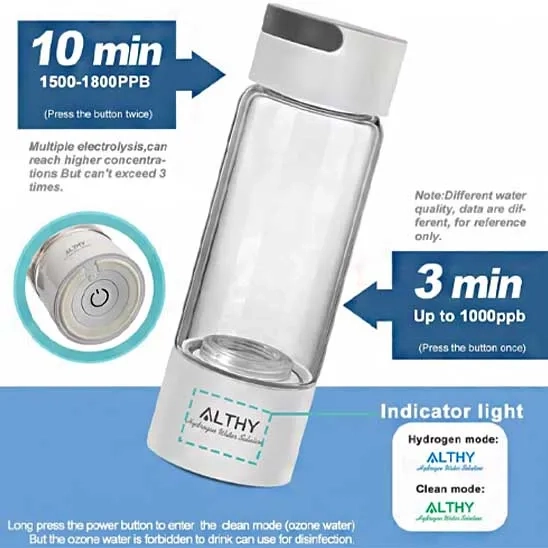
3. Assessing Your Specific Needs Before Purchase
Before purchasing an appropriate hydrogen water generator, it is vital to evaluate your particular needs to select a device that adequately fulfills your requirements. This process includes understanding the level of hydrogen you need and setting a reasonable budget. By adhering to the following steps, an informed decision can be guaranteed.
3.1. Calculate Your Requirements
It is important to identify the level of hydrogen concentration you need based on your application to choose the best hydrogen water generator that you require. The hydrogen concentration among the models usually varies from 0.5 to 1.6 parts per million (ppm), and a higher concentration is better. If you are an average person who wants to use the bottle for its benefits, a concentration of 1 ppm can cover your needs. However, if you are a professional athlete, a higher hydrogen concentration is needed. You must thus purchase more sophisticated models with hydrogen concentrations up to 1.6 ppm. Another important factor to consider is electrolysis technology. PEM is sensitive to the quality of the water, especially ions like chloride. Users must consider this fact since chloride is used in water treatment plants and its level can be high in tap water. Therefore, if the water that you intend to use in the bottle for generating hydrogen water has low quality, the PEM electrolysis is not suitable for you. Another element is capacity. If your water needs are higher than average, it is advisable to select a pitcher-based hydrogen water generator with a high capacity (1 to 2 liters). This can minimize the degradation of the electrode plate since you have lower hydrogen cycle production. Also, it can save the power of the device, minimizing frequent charging.
3.2. Set Your Budget
The price of the hydrogen water generators is important, which can vary significantly based on elements like electrolysis technology, type, size, material, capacity, and brand. By determining the budget, you can narrow down your options. The hydrogen water generator has a range from less than $50 to more than $100. The regular models that have a price below $100 offer suitable hydrogen concentration and borosilicate glass material; models like the Zasabel Hydrogen Water Bottle are in this category. Next, the price range is higher than $100. Models in this class offer additional features and more water capacity. For example, GOSOIT Hydrogen Alkaline Water Pitcher, with a price of $100, is a cutting-edge hydrogen generator device that utilizes advanced technology to create hydrogen-rich alkaline water for several health benefits. This hydrogen water generator is equipped with the latest SPE (platinum-coated titanium) electrolysis plates and a long-life proton membrane (PEM) made in the USA. It only electrolyzed water into H+ and OH- and no other harmful substances like ozone or chlorine. It has a shining feature that makes it distinct. The GOSOIT hydrogen flask is suitable for various age groups. The activated hydrogen in the alkaline water has several benefits for our general health and well-being. It promotes cell activation, enhances immunity, improves digestion, and boosts metabolism.
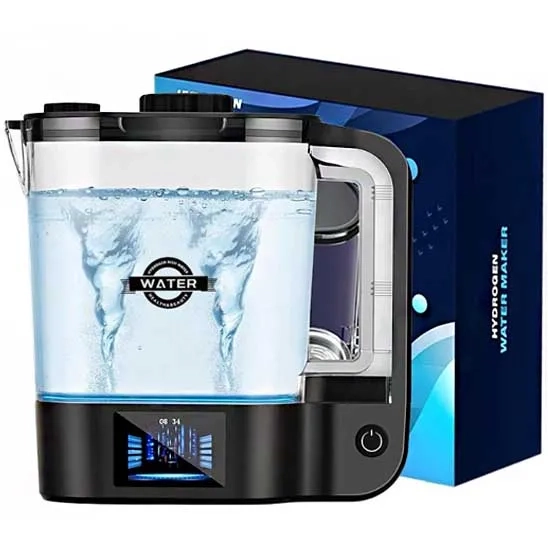
4. Mistakes to Avoid When Choosing Hydrogen Water Generator
When choosing a hydrogen water generator, there are certain key factors that need to be known to avoid any mistakes, which will be evaluated in this section of the buying guide. One of the most common mistakes is to overlook the application. If you want to use the device as a family, the pitchers for generating hydrogen water are better because they can offer high capacity, and although they are slow, using them during the day is not a problem. On the other hand, if you want to use the hydrogen generator on the go, a lightweight bottle is better as it can offer portability. Another factor to consider is the electrolysis technology. PEM technology is sensitive to the quality of the water. Therefore, if you tend to use low-quality water, the hydrogen water generator with PEM is not a good choice. Water treatment plants use chloride, which particularly sensitively affects PEM when recycling tap water. Moreover, to avoid selecting cheap hydrogen water generators with low-quality material and a short life span, try to find a product that has BPA-free FDA approval or NSF certification. If you want to use the product in the gym or outside, do not select bottles with glass because they are fragile. Instead, look for stainless steel and materials that are impact-resistant.
5. Checklist for Choosing the Best Hydrogen Water Generators
Have you recognized the type of hydrogen water generator that is best based on your application? (e.g., bottle-based or pitcher-based.)
Have you recognized the electrolysis technology that is best based on your application? (e.g., Proton Exchange Membrane or alkaline.)
Have you identified the quality of the water source you intend to use with the hydrogen water generator?
Have you identified the main application? (e.g. indoor, outdoor, etc.)
Does the expense align with your budget while maintaining the overall requirements and keeping the right balance between expense, features, and durability over time?
Are the materials durable and aligned with the environment in which you plan to use the products? (glass, plastic, stainless steel)
Have you searched for the customer service and availability options? (e.g., warranty, professional assistance, return policy, rapid delivery, packaging, free monitoring service ,and responsiveness)
Have you looked into product rankings and assessments to guarantee dependability? (e.g., Bayesian Rank, buying guides, reviews, comments, etc.)
6. Where to Buy Hydrogen Water Generators
Presently, a few companies offer hydrogen water generators. To maximize your experience, try to select a popular company in this area. Companies like Level Up Way, PIURIFY, Pansonite, GOSOIT, Fossduck, LAYJU, WUGOSU, and ALTHY are well-known in the market, offering a wide range of products from pitcher-based to bottle-based hydrogen water generators. It is advisable to buy from these companies since they are reputable in these fields and produce different products. For buying from them, you can use online platforms. Amazon stands out as a trustworthy option, offering everything from affordable models to premium ones. Users can compare features and ratings and read practical reviews to identify any flaws. With secure purchasing, rapid shipping, and reliable customer service, Amazon has a global reach, though it primarily ships from the USA. Walmart also offers bottles for generating hydrogen water and similar features, but has a smaller selection and physical stores in the USA and Canada.
7. Conclusion
This buying guideline provides an extensive guide for buying hydrogen water generators, encompassing key features like purpose and application, electrolysis technology, capacity and size, and material. This buying guide supports different types of hydrogen water generators, including pitcher-based and bottle-based. While they offer large capacity, they are bulkier, which reduces their portability. Among the different electrolysis technologies, alkaline is better for you if the water you plan to use has low quality. In the end, this buying guide has provided a checklist that individuals can use before buying hydrogen water generators to ensure they consider every single detail and optimize their selection. This detailed buying guide for hydrogen water generators helps users choose a device that not only fulfills their current needs but also accommodates future demands, ensuring optimal water quality while potentially reducing maintenance and costs.
